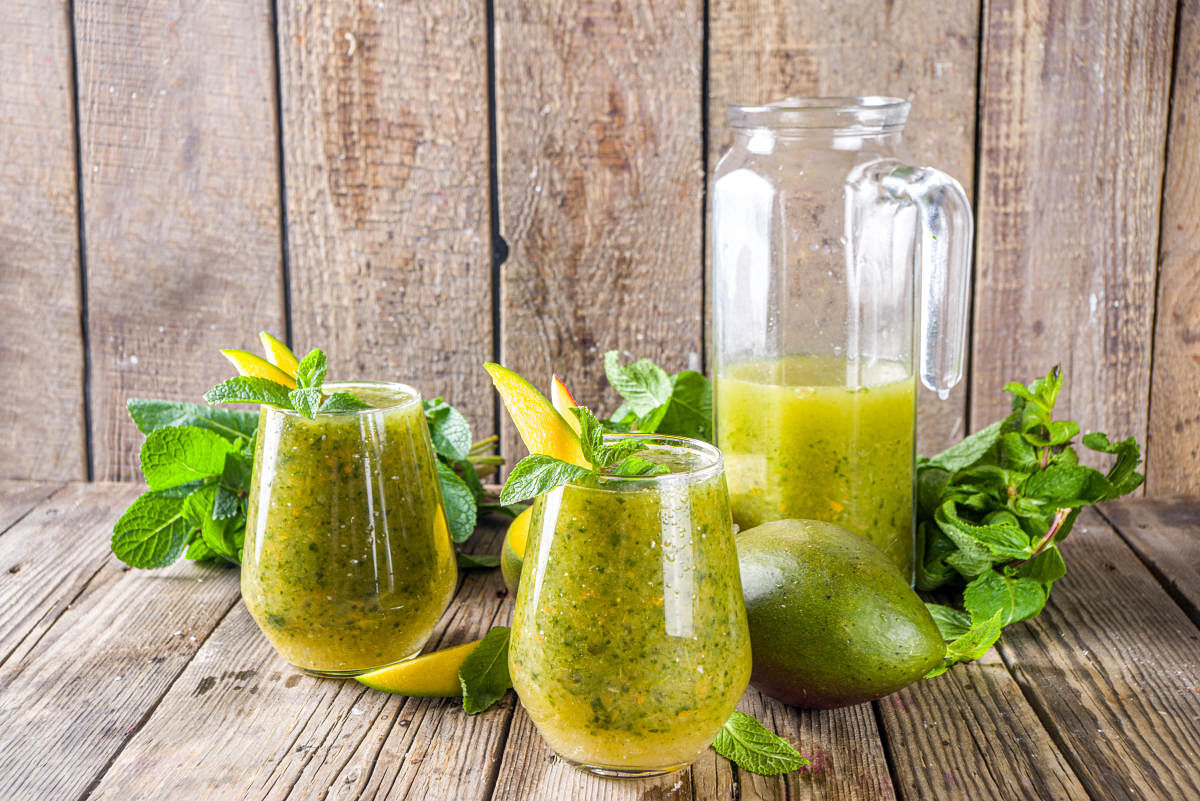
From the dry plains to the humid coastal region, stepping out in the sweltering summer heat is a daily struggle as it leaves you dehydrated and fatigued. When the dusty gusty loo (hot and dry summer wind) blows across the northern plains, the aam panna (raw mango drink) in matkas (clay pots) on roadsides can be a saviour. Spiced up with roasted jeera (cumin seeds), sprinkled with kala namak (rock salt) and garnished with pudina (mint), it is an elixir for parched throats.
Further south, Nungu sharbat is an instant thirst quencher on Tamil Nadu’s streets. The tender ice apple of the palmyra tree is combined with nannari syrup, made of Sarsaparilla roots (nannari, ananthmoola or anantvel), known for its cooling properties. Madurai’s famous milk drink, Jil Jil Jigarthanda has badam pisin (almond bark gum) and nannari syrup.
Across India, the go-to summer drink is nimbu-pani (lemonade), served sweet or salted, with a dash of zesty lemon and zingy ginger, and the tangy and digestive jal jeera (dry mango powder and cumin drink).
Buttermilk is a quintessential cooler that has many regional versions. The north’s light and frothy buttermilk, Bengal’s Gondhoraj ghol with the juice of fragrant Gondhoraj (native green oblong lemon), Tamil Nadu’s neer more and Kerala’s sambaram are spicy versions of buttermilk.
Punjab is known for its sweet and creamy lassi, churned in matkas, and poured into tall glasses. In Uttar Pradesh, the earthy flavour of kulhad lassi is enjoyed with a dollop of malai (thick cream) on the top. Nowadays lassi is getting trendier as smoothies are made with mango, banana or strawberry; garnished with cut fruits, grated coconut, rabdi, cherries or nuts.
The summer sharbat made of ingredients like curd, lemon, cold milk, seasonal fruits and berries, palm sugar, herbs and spices and edible gums has many health benefits. They are centuries-old natural remedies that hydrate naturally, prevent heatstroke, aid in digestion, cure nausea and boost immunity.
The appetising drinks are also visually appealing. Uttarakhand’s magenta buransh (petals of rhododendron), known to combat mountain sickness, the orangish smoothie of sweet and astringent bael (wood apple or stone apple), red watermelon juice, purple jamun (Indian gooseberry), the Konkan coast’s pink sol kadhi (coconut milk and kokum (amsul) syrup), sparkling red kokum sharbat, yellowish green aam panna and green khus-khus (vetiver) drink; the list goes on.
Some summer drinks are closely associated with Indian festivals. “I had the divine Chabeel in Nada Sahib Gurudwara in Chandigarh,” says Navi Mumbai-based chef consultant and culinary expert, Reetu Uday Kugaji. She has a penchant to discover regional recipes for food and drinks. Chabeel or kachi lassi is a rose-flavoured summer drink served along roadsides in Delhi and Punjab during the Shaheed Diwas of Guru Arjan Dev ji in May. “Kashmir’s Babri Beol, Bohra’s Gol paani and Tamar Al Hindi (sweet tamarind drink) are Ramadan summer drinks.”
In the south, panakam — a concoction of water, jaggery, cardamom, dry ginger, and mint leaves, and neer more, the spicy watery buttermilk is associated with Ramnavmi. In the north, thandai (made with milk, aromatic spices, and dry fruits) is served during Holi and Mahashivratri.
“An edible gum like gond katira (tragacanth gum) and sabja seeds (sweet basil seeds) have a cooling effect,” says Reetu. The falooda (flavoured milk and vermicelli noodles), lesser-known Odisha’s landa baguli dohi sharbat (curd drink), Babri Beol, Gol paani and Kerala’s Kulukki sharbat have sabja seeds.
Great for summers are some regional specialities like ragi ambali (finger millet mixed with buttermilk) of Karnataka and sattu ka sharbat (ground roasted chickpea mixed with water) of Bihar.
“Rajasthan has jou ki rabdi (barley cereal) that is one full meal, and a great coolant for the body,” says Ani Setia, founder of Go Satvik, a cloud kitchen and cooking class in Jaipur.
A must in rural households, it is sold by street vendors in cities. “The jou is finely ground and mixed with buttermilk, and tastes delicious when served in a kulhad garnished with mint leaves,” adds Ani.